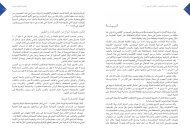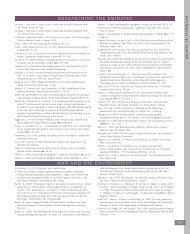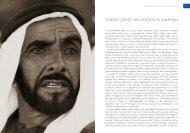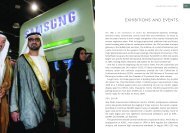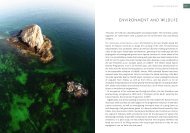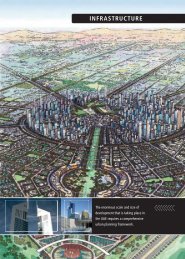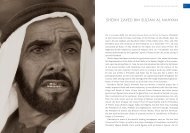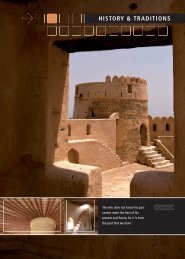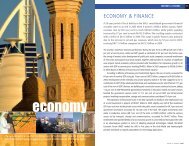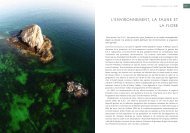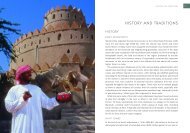144UNITED ARAB EMIRATES YEARBOOK 2006<strong>ECONOMIC</strong> <strong>DEVELOPMENT</strong>1451980s and a 4000 t/y grease plant in Umm al-Nar. The Ruwais BOR provides afurther boost to Abu Dhabi’s lubricants production, from 50,000 t/y to 90,000 t/yby 2005/06.In late 2003, Takreer commenced work on its central Environment ProtectionFacility for the <strong>UAE</strong> (BeeAT), awarding an EPIC (engineering, procurement,installation and commissioning) contract worth US$47.4 million. The new facilitywill comprise several waste treatment units and is scheduled for completion inmid-2006. Its task will be to safely receive, manage, treat and dispose of wastegenerated by ADNOC and its group of companies.Abu Dhabi also has direct interests in refining and distribution ventures outsideof the <strong>UAE</strong>. It owns equity in six refineries, with a total capacity of 642,500 b/d,and service station networks totalling 2800 outlets in various countries. Theseinterests are held and managed by the government’s foreign investment arm, theInternational Petroleum Investment Company (IPIC).A bulk oil products storage facility, established at Hamriyah in April 2001, wasdeveloped by National Oil Storage Company (NOSCO): a 50–50 joint venturebetween two Sharjah-based companies, Gulf Energy and Union Energy. It comprisessix storage tanks, two of 10,000 tons, two of 6000 tons and two of 5000 tons,for holding diesel oil, fuel oil and bitumen.FujairahFujairah has capitalised on its strategic location on the Gulf of Oman by providingoil storage and bunkering services to shipping. These comprise eight 11,500-tontanks and three 40,000-ton tanks. In addition, a separate and larger storage andblending facility is owned and operated by a consortium that includes EmiratesNational Oil Company (ENOC). Fujairah Port is the world’s second largest shiprefuelling centre and has the third largest container terminal in the <strong>UAE</strong>.OIL EXPORTSDubaiWhilst Dubai does not have any crude oil refining facilities, it does possess a120,000 b/d condensate refinery that began operations in 1999. It wasdeveloped by government-owned Emirates National Oil Company (ENOC) at acost of Dh1.3 billion and consists of two 60,000 b/d trains, one for sweet andone for sour condensate. The plant produces a large proportion of the LPG, jetfuel, gas oil and bunker fuel consumed in Dubai, as well as exporting some66,000 b/d of naphtha. ENOC is upgrading the refinery to enable it to operateat full capacity and produce gasoline and naphtha with very low sulphurcontent. This work is scheduled for completion in 2007.Several oil-reprocessing and lube-oil blending plants are situated at Jebel Ali,including a lube-oil blending and packaging plant that can produce 60,000 t/yof lubricants, and its output is marketed throughout the Gulf region as well as inthe <strong>UAE</strong>. An oil-processing plant for producing gasoline additives and conditioningproducts has been developed by Ducham, a subsidiary of Abu Dhabi-based StarEnergy Corporation. This has a capacity of 20,000 b/d of unleaded gasoline, 360ton/day (t/d) of aromatics and 240 t/d of raffinate. Gadgil Western Corporation(GWC) runs a fuel-oil reprocessing plant with a capacity of 275,000 t/y. France’sTotal has licensed ENOC to use its Jebel Ali based lube-oil blending plant to produce5 million litres/year of lubricants, with a possible increase to 6.5 million litres/yearat some future date.SharjahFal Oil operates a lubricants plant in Sharjah that started in 1979 and producesa variety of products for automotive, marine and industrial use. It was theemirate’s second lube-oil blending plant, following that developed in 1976 bySharjah National Lube Oil Company (Sharlu).Central Bank figures indicate that the <strong>UAE</strong> earned Dh108.79 billion from oil sales,Dh15.16 billion from exported petroleum products and Dh17.23 billion fromexports of natural gas in 2004. Total oil and gas exports thus reached a record levelof Dh141.18 billion, which was Dh32.61 billion more than the previous year.The increased revenues led the Federal Government to produce a balanced budgetfor 2005, the first time it had done so since 1981.Abu DhabiAbu Dhabi increased its oil production in 2004 by around 55,000 b/d, to around1.72 mb/d. Japan remained its chief customer and the <strong>UAE</strong> also retained its positionas Japan’s main crude oil supplier for most of 2004, accounting for about aquarter of Japan’s total crude oil imports. Abu Dhabi sends more than half itscrude oil to Japan. Most of Abu Dhabi’s crude oil exports, comprising four grades ofcrude, Murban (39° API), Lower Zakum (39° API), Umm Shaif (37° API) and UpperZakum (33° API), are sold to the Far East. After Japan, the main importers areTaiwan, Thailand, India, Pakistan, Sri Lanka and Bangladesh.Abu Dhabi’s condensate exports continued to rise in 2004, reaching almost400,000 b/d. These exports have no effect on the amount of crude that theemirate can export, since condensate is not covered by OPEC’s oil productionquota arrangements.Abu Dhabi’s refined products, above those used in the local market, are exportedby ADNOC Distribution (ADNOC-FOD), which sells oil products and lubricants bothto the Far East and to Arab and African countries. India is the leading exportmarket for Abu Dhabi’s refined products, absorbing over half its gas-oil exportsas well as substantial volumes of kerosene and LPG. Japan now accounts for aboutone-third of the emirate’s refined product exports, down from 50 per cent in1993, but remains the largest market for naphtha.
146UNITED ARAB EMIRATES YEARBOOK 2006<strong>ECONOMIC</strong> <strong>DEVELOPMENT</strong>147DubaiDubai exports all the crude oil it produces, mostly to the Far East. Dubai crude(31° API) is mainly sold on the spot market, and, despite its very limited volume,serves as a price marker for some other Gulf producers. In 2004 the price averagedUS$33.5/b, as against US$26.85/b in 2003.GASThe <strong>UAE</strong>’s natural gas reserves of 213.5 trillion cubic feet (tcf) are the world’sfourth largest after Russia, Iran, and Qatar. The largest reserves of 198.5 tcf(approximately 93 per cent of the <strong>UAE</strong> total) are located in Abu Dhabi, with therest shared by other emirates. Current gas reserves are projected to last forabout 150 to 170 years at present rates of production. Gross production by AbuDhabi rose to approximately 65 billion cubic metres (6.3 billion cubic feet/day) in2004. Onshore gas fields accounted for about 4.8 billion cubic feet/day (cf/d),whilst offshore fields contributed around 1.4 billion cf/d. The non-associatedKhuff gas reservoirs beneath the Umm Shaif and Abu al-Bukhoosh oil fields inAbu Dhabi rank among the world’s largest. A project to boost gas productionfrom these fields was completed in 2004.Development of gas production also increases exports of condensates, whichare not subject to OPEC quotas. Abu Dhabi Gas Industries Ltd (GASCO) handlesassociated gas from ADCO’s onshore crude production and processes it throughthree NGL extraction plants at Bab, Bu Hasa and Asab. Offshore, the Abu Dhabi GasLiquefaction Company (ADGAS) handles associated and non-associated gas fromoffshore fields at its plant on Das Island. The bulk of the output is sold to Japan.In addition to the growing volume of gas that is re-injected into oil fields (over1 billion cf/d in 2004), the country’s power stations, desalination plants and otherindustrial projects depend on burning gas, rather than oil, driving gas consumptionto 4.5 billion cf/d in 2004, a figure that is expected to soar to 5 billion cf/d by2007. At present consumption rates, 71.4 per cent of gross gas production isconsumed within the country. This does not include the figure of around 1.5 billioncf/d that is re-injected into oilfields as part of the production boosting measures.The <strong>UAE</strong> has been an exporter of natural gas since 1977. Rapid growth inproduction follows a development programme involving three separate projectsto enhance recovery of associated and non-associated Khuff gas from onshorereservoirs. Gross (marketed) natural gas production in 2004 has been estimated at49.2 billion cubic metres (cu m). Liquified natural gas (LNG) exports totalled 7.6billion cu m while exports of natural gas liquids (NGLs) reached 13.6 billion cu m.SUPPLY NETWORKSIf further confirmation was needed that the <strong>UAE</strong> sees gas and not oil as the answerto its future energy needs, construction of a new project for natural gas distributionthroughout Abu Dhabi should persuade any doubters that this is indeed the wayforward. The new pipeline network will deliver clean burning natural gas forcommercial and residential purposes. The estimated Dh1billion initiative comeson the back of increased natural gas availability as several development andexpansion projects are under way. In the first phase, the natural gas distributionnetwork will cover 120,000 commercial and residential users in Abu Dhabi, AlAin and one or two nearby towns. ADNOC Distribution, a subsidiary of ADNOC,is overseeing the project.Industry sources and government officials share the view that Abu Dhabi willhave an abundance of natural gas once major expansions come on-stream. Theonshore gas development projects 2 and 3, Bu Hasa, Bab and others are all beingexpanded, making more natural gas available. To this can be added the supply ofQatari gas under the mega Dolphin gas initiative that will come on-stream in 2006.On 29 May 2005 the foundation stone for the Dolphin Energy’s gas processingplant in Ras Laffan was laid by Qatari Crown Prince Sheikh Tamim bin HamadAl Thani. The new plant, to be built at a total cost of US$1.6 billion, will supplyabout 2.5 bcf/d of gas.Even the <strong>UAE</strong>’s cars are likely to switch to gas as a fuel in the future. ADNOCDistribution has been engaged in a pilot project for use of natural gas by taxis inAbu Dhabi. Initially 48 taxis in the capital have been fitted to run on gas insteadof gasoline. The natural gas filling station is near Mina (Port) Zayed. Future plansinclude the use of natural gas by all taxis in Abu Dhabi, Al Ain and nearby areas.Abu DhabiAbu Dhabi government is sole owner of all natural gas resources on its territory,both onshore and offshore, whether in associated or non-associated form. TheAbu Dhabi National Oil Company (ADNOC) is responsible for developing andmarketing these resources on the government’s behalf and is authorised to formpartnerships with foreign companies for that purpose, so long as it retains at leasta 51 per cent interest in any venture. Abu Dhabi’s proven natural gas reserves wereestimated at 198.5 trillion cubic feet (tcf)) on 1 January 2005, representing around93 per cent of the <strong>UAE</strong>’s total gas reserves of 213.5 tcf. Meanwhile, Abu Dhabi’sgross gas production reached 65 billion cubic metres (bcm) (6.3 billion cf/d) in2004, comprising about 4.9 billion cf/d from onshore fields and 1.4 billion cf/dfrom offshore fields.The impressive production figures are the result of a sustained developmentprogramme involving the second and third onshore gas development projects(OGD-2 at the Bab field and AGD-1 at the Asab field). These are operated by theAbu Dhabi Gas Company (GASCO), which also operates the massive gas processingplant at Habshan, built in 1983 to process associated gas from the Thamama Creservoir of the Bab oilfield, and which today also processes non-associated gasfrom the Thamama B, D and F reservoirs and Thamama units 6 and 7 at Bab.



